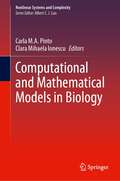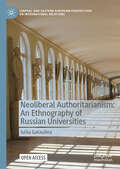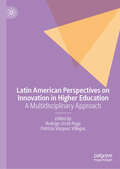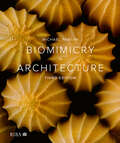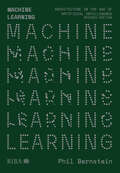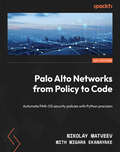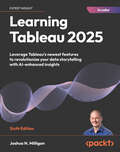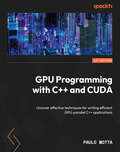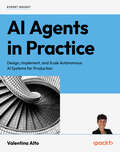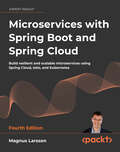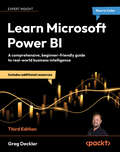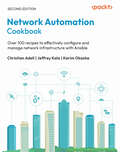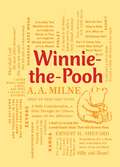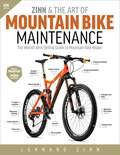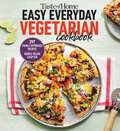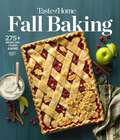- Table View
- List View
Computational and Mathematical Models in Biology (Nonlinear Systems and Complexity #38)
by Clara Mihaela Ionescu Carla M.A. PintoThis book provides the most valuable and updated research on computational and mathematical models in biological systems from influential researchers around the world and contributes to the development of future research guidelines in this topic. Topics include (but are not limited to): modeling infectious and dynamic diseases; regulation of cell function; biological pattern formation; biological networks; tumor growth and angiogenesis; complex biological systems; Monte Carlo methods; Control theory, optimization and their applications
Global Perspectives on Learning Cities (Lifelong Learning Book Series #35)
by Séamus Ó Tuama Eric Agbessi Tina NeylonThis book examines the social, political and economic rationales, which lead to the development of learning cities in diverse settings in Africa, Australia, Asia and Europe. Many of the contributors are practitioners who have played an active part in the development of their learning city. Some contributors are both practitioners and researchers on learning cities. Some are primarily researchers who are focused on understanding learning cities, gauging the benefits and potential of learning cities and formulating new theories and approaches. The book also includes interviews with and contributions from key founding figures in the learning cities movement and in the development of UNESCO&’s Global Network of Learning Cities. The book explores diverse initiatives that are shaping the lives of people in cities today and into the future, fostering inclusivity, sustainability, and resilience. Each chapter offers a unique perspective on the transformative power of lifelong learning and collective commitment. Contributors share their insights, from grassroots to high level policy discussions, shedding light on the challenges and triumphs encountered along the way. This is the first major book looking at learning cities across the globe from both theoretical and practical perspectives. What sets it apart is the diversity in the material offered and the geographical and cultural spread of contexts. Cities are becoming ever more important to the future of humanity, learning cities are a vast laboratory of new and innovative ways in which people can learn together to create more fulfilling lives, better opportunities and put into practice on a daily basis the four principles outlined in the Delors Report (1996): Learning to know, Learning to do, Learning to live together, Learning to be. This book is a valuable resource for policymakers, educators, and community leaders striving to build more inclusive and sustainable societies. Whether embarking on the journey of developing a learning city or seeking inspiration from successful initiatives, readers will find practical insights and thought-provoking perspectives within these pages.
Neoliberal Authoritarianism: An Ethnography of Russian Universities (Central and Eastern European Perspectives on International Relations)
by Iuliia GataulinaThis open access book delves into the politics of oppression and dispossession driven by global neoliberalism and state authoritarianism. Challenging liberal biases, it introduces the concept of "neoliberal authoritarianism," highlighting how the Russian state has transformed within the context of neoliberal globalization into a new state formation where authoritarianism is reinforced by neoliberal rationalities. The book analyzes neoliberal authoritarianism through an ethnographic lens on universities and their governance, which have become a new frontier of neoliberal economic development, serving the imperatives of growth and competition.
Latin American Perspectives on Innovation in Higher Education: A Multidisciplinary Approach
by Rodrigo Urcid-Puga Patricia Vázquez VillegasThis book highlights educational innovations from Latin American researchers, offering culturally relevant practices and perspectives. This approach provides valuable and underrepresented viewpoints for a global audience interested in diverse approaches to education. It integrates theory and practice by seamlessly combining theoretical frameworks with real-world case studies, making it academically rigorous and practically applicable. This balance ensures its appeal to educators, researchers, and policymakers seeking innovative strategies. The text includes practical cases from professors that teach at undergraduate and postgraduate level, also includes some experiences reinforced with a solid theoretical framework. The different chapters aims to meet several needs, including enhancing teacher professionalization, disseminating best teaching practices, and providing first-hand access to real cases inside and outside the classroom. It also seeks to update university faculty and administrators on topics related to educational innovation while serving as a reference for undergraduate and graduate students.
No-Budget Feature Filmmaking in the Digital Era: Cinema in Ones and Zeroes
by Adam NixonThis book chronicles the transformative impact of CMOS sensor technology on the global DIY filmmaking community. Through the lens of an ethnographer and outsider filmmaker, the author explores how digital cameras have democratized the art of filmmaking, allowing amateurs to create professional-quality films on a shoestring budget. The journey begins with the author's own experience creating Aspirin for the Masses, a feature film shot for just $500, and extends into the broader world of no-budget filmmaking. Key concepts include the rise of the "Am-Auteur," the role of film festivals in identity creation, and the cultural capital of low-cost cinema. The book examines how digital technology has redefined notions of media dissolution and creation, offering new pathways for identity formation. It also delves into the performative aspects of film festivals, where outsider artists gain socio-cultural status. This book is essential for scholars, filmmakers, and anyone interested in the intersection of technology and art. It offers a unique perspective on how digital cameras have reshaped the filmmaking landscape, empowering a new generation of creators to challenge traditional norms and redefine what it means to be an auteur in the digital age.
Biomimicry in Architecture
by Michael PawlynRegenerative design requires transformative approaches. Biomimicry provides a perspective that radically rethinks architecture, from the materials we use to the cities and systems we create. Biomimicry harnesses not just natural beauty but the remarkable array of adaptations that species have perfected over millennia. With the climate crisis escalating, biomimicry is no longer just an inspiration, it is an imperative. It recognises that 'we are nature' and rather than viewing the living world as separate to us - to be plundered for resources and pollution - we are intrinsic to it.While industries such as manufacturing, transportation and product design have embraced biomimicry as a driver of sustainability, architecture has yet to unlock its full potential. This must change. Nature holds the key to designing buildings and systems that can be net positive and show that humans can become responsible stewards of planet Earth. The adaptations that have evolved in the living world can inspire radical, game-changing solutions: self-repairing structures, air-conditioned termite mounds and the extraordinary water-harvesting abilities of a desert beetle. These innovations have been tested through 3.8 billion years of evolution, offering architects the chance to revolutionise the way we build and live.Biomimicry in Architecture explores how nature's ingenuity can transform everything from structural efficiency and material innovation to water conservation, energy systems, and even the design of entire cities.Featuring awe-inspiring biological strategies, this book presents urgent, real-world solutions for a sustainable future. Completely rewritten and updated with new content and illustrations, this edition puts forward a transformative case for biomimicry as a discipline that shows how to design as nature and integrate everything we do as humans into the web of life that supports us. The future depends on it.
Machine Learning: Architecture in the age of Artificial Intelligence
by Phil Bernstein‘The advent of machine learning-based AI systems demands that our industry does not just share toys, but builds a new sandbox in which to play with them.’ - Phil BernsteinThe profession is changing. A new era is rapidly approaching when computers will not merely be instruments for data creation, manipulation and management, but, empowered by artificial intelligence, they will become agents of design themselves. Architects need a strategy for facing the opportunities and threats of these emergent capabilities or risk being left behind.Architecture’s best-known technologist, Phil Bernstein, provides that strategy. Divided into three key sections – Process, Relationships and Results – Machine Learning lays out an approach for anticipating, understanding and managing a world in which computers often augment, but may well also supplant, knowledge workers like architects. Armed with this insight, practices can take full advantage of the new technologies to future-proof their business.Features chapters on: Professionalism Tools and technologies Laws, policy and risk Delivery, means and methods Creating, consuming and curating data Value propositions and business models.
Palo Alto Networks from Policy to Code: Automate PAN-OS security policies with Python precision
by Nikolay Matveev Migara EkanayakeCreate automated security policies for Palo Alto Networks firewalls that transform manual processes into scalable, code-based solutionsKey FeaturesStreamline security policy deployment using Python and automation toolsLearn how PAN-OS processes and secures enterprise network trafficImplement automated security actions for real-time threat mitigationGet With Your Book: PDF Copy, AI Assistant, and Next-Gen Reader FreeBook DescriptionPalo Alto Networks firewalls are the gold standard in enterprise security, but managing them manually often leads to endless configurations, error-prone changes, and difficulty maintaining consistency across deployments. Written by cybersecurity experts with deep Palo Alto Networks experience, this book shows you how to transform firewall management with automation, using a code-driven approach that bridges the gap between powerful technology and practical implementation. You’ll start with next-gen firewall fundamentals before advancing to designing enterprise-grade security policies, applying threat prevention profiles, URL filtering, TLS decryption, and application controls to build a complete policy framework. Unlike other resources that focus on theory or vendor documentation, this hands-on guide covers best practices and real-world strategies. You’ll learn how to automate policy deployment using Python and PAN-OS APIs, structure firewall configurations as code, and integrate firewalls with IT workflows and infrastructure-as-code tools. By the end of the book, you’ll be able to design, automate, test, and migrate firewall policies with confidence, gaining practical experience in quality assurance techniques, pilot testing, debugging, and phased cutovers—all while maintaining security and minimizing business impact.What you will learnMaster next-generation firewall fundamentalsDesign enterprise-grade security policies for the Internet gatewayApply App-ID, URL filtering, and threat preventionAutomate policy deployment using Python, PAN-OS APIs, SDKs, and IaC toolsCustomize response pages with Jinja2 and integrate them into service desk workflowsTest and validate with QA techniques and pilot testingMigrate policies with confidence and zero downtimeWho this book is forThis book is for firewall engineers, security engineers, consultants, technical architects, and CISOs who want to enhance their network security expertise through Policy as Code on Palo Alto Networks firewalls. It's also perfect for those with working knowledge of Python programming and hands-on experience with Palo Alto Networks' Next-Gen firewalls, whether in business, government, or education. This book will help network engineers, security architects, and DevSecOps professionals simplify firewall management and reduce operational overhead.
Inclusive Design for Accessibility: A practical guide to digital accessibility, UX, and inclusive web and app design
by Dale Cruse Denis BoudreauThrough insights from twelve industry voices, learn how to create truly accessible and inclusive digital experiences that work for everyone, regardless of ability and backgroundKey FeaturesUnderstand inclusive design principles that will help you achieve universal usabilityGain insights into AI and emerging technologies shaping the future of accessibilityDrive organizational change with practical strategies to build an inclusive design culturePurchase of the print or Kindle book includes a free PDF eBookBook DescriptionDespite our growing reliance on digital technology, millions of users are still excluded from fully engaging with websites, apps, and digital services because nobody thought to design for them. Inclusive Design for Accessibility challenges you to rethink how you build digital experiences, offering the tools and guidance needed to move beyond compliance and create experiences that work for everyone. With contributions from twelve accessibility leaders—Dale Cruse, Denis Boudreau, Dr. Angela Young, Maya Sellon, Julianna Rowsell, Nandita Gupta, Jennifer Chadwick, Crystal Scott, Chris McMeeking, Dr. Keith Newton, Charlie Triplett, and Kai Wong—this book lays out the fundamentals of inclusive design and its application in advanced and emerging technologies. You'll discover practical strategies and real-world examples that show you how to embed accessibility into projects, from user research and testing to creating accessible websites and mobile apps. You’ll also focus on how AI can enhance accessibility and learn to tackle the challenges posed by VR and AR. For designers, developers, product managers, and business leaders, this book will reshape how you approach inclusive design, helping you move beyond ticking boxes toward building digital products that don't leave anyone behind.What you will learnMaster the core principles of inclusive design to create products that serve allConduct diverse user research to gain insights into accessible experiencesImplement accessibility best practices in your web and mobile deploymentsCreate fully accessible content in text, audio, and video formatsExplore the accessibility challenges and opportunities with AI, VR, and ARNavigate the legal and ethical implications of accessibility to protect users and your brandEstablish accessibility-focused workflows and practices in your teamsWho this book is forThis book is for digital designers, developers, UX professionals, product managers, and business leaders committed to inclusive design. It offers practical skills for creating accessible digital products, while covering legal and ethical considerations, user research, and strategies for building an accessibility-focused culture within teams. You don’t need to be an expert in UX design, web development, or accessibility to get value from this book. Each chapter delivers actionable insights that stand on their own, be it UX design, product management, development, or accessibility leadership.
Getting Started with the Graph Query Language (GQL): A complete guide to designing, querying, and managing graph databases with GQL
by Ricky Sun Jason Zhang Yuri SimioneLearn how to build and query graph databases with this first comprehensive guide to ISO-standard GQL featuring 50+ hands-on examples and a real-world case study that will change the way you work with connected dataKey FeaturesGo beyond theory and apply key concepts and syntax through interactive tutorials and practical examples via the GQL PlaygroundLeverage advanced features of GQL to manipulate graph data efficientlyExplore GQL applications in data analytics and discover how to leverage graph knowledge in real-world scenariosPurchase of the print or Kindle book includes a free PDF eBookBook DescriptionGraph Query Language is becoming the go-to standard for graph databases, especially with its support for interconnected analytics and GenAI capabilities. This book comes from a team of industry veterans who know exactly how to break down the fundamental GQL concepts, graph terms, definitions, catalog systems, and everything that matters in actual work. You’ll get to grips with graph data types, value expressions, graph matching patterns, and modifying statements through practical GQL examples. With access to the GQL Playground via Ultipa Graph, you’ll get hands-on experience querying and manipulating graph data. Once you've got the basics down, you’ll tackle advanced GQL topics such as path modes, complex path matching patterns, shortest path queries, composite statements, session and transaction commands, and procedures. You’ll also learn to create extensions and understand the design of graph databases to solve industry issues. The authors cover techniques like property graphs to help you optimize your graph queries and offer insights into the future of GQL and graph technology. By the end of this book, you’ll confidently query and update graph data, run graph algorithms, and create visualizations. Plus, you’ll apply your learnings to a real-world use case of money flow analysis for assessing bank client behaviors and detecting transaction risks.What you will learnExperiment with GQL syntax on GQL Playground, including MATCH, RETURN, INSERT, UPDATE, and DELETEWork with operators, functions, and variables in an organized fashionBecome familiar with complex topics such as varying path matching modes, repeated variables, shortest path, procedures, and transactionsEnhance execution speed through indexing or caching systemsUnderstand how to manage access control effectivelyTackle real-world issues with a case study focused on money transaction analyticsWho this book is forThis book is for graph database developers, DBAs, programmers, data engineers, and analysts who want to learn the new graph database standard GQL. A basic understanding of graph and relational databases, data models, knowledge of SQL basics, and programming will make the content easy to grasp. While it is designed to be accessible even if you don’t have a background in graph theory, familiarity with concepts like nodes, edges, relationships, and the distinction between directed and undirected graphs will enhance your learning experience.
Learning Tableau 2025: Leverage Tableau's newest features to revolutionize your data storytelling with AI-enhanced insights
by Joshua N. MilliganExplore the full potential of Tableau and learn how to draw valuable insights from data directly from a Tableau Visionary and Zen MasterKey FeaturesLearn Tableau's foundational principles while exploring new AI features like Tableau Pulse and AgentTransform complex datasets into interactive insights with Tableau PrepGain deeper insights using geospatial analysis and advanced methodsPurchase of the print or Kindle book includes a free PDF eBookBook DescriptionTableau 2025 marks a new era in data visualization and analysis, bringing together advanced AI integrations and dynamic user experiences. This sixth edition, written by Tableau Visionary and Zen Master Joshua Miligan, is an end-to-end guide to mastering the latest innovations in Tableau that transform raw data into actionable insights. This edition introduces groundbreaking features like Tableau AI (including Tableau Pulse and Tableau Agent), enhancing your analytical capabilities with AI-driven data exploration and automated insights. With detailed walkthroughs, you’ll learn to build dynamic dashboards that respond to your data in real time and work with sophisticated AI functionalities that predict trends and model scenarios. Whether you're a seasoned data professional or new to Tableau, this book provides the tools you need to leverage Tableau’s full potential. From integrating diverse data sources using the enhanced data model to employing advanced geospatial functions for detailed mapping, every chapter is packed with expert knowledge and practical applications designed to put powerful analytics at your fingertips.What you will learnImplement advanced AI features to streamline data analysisBuild and customize dynamic dashboards for interactive data storytellingLeverage new geospatial functions for comprehensive mappingEnhance data prep with Tableau Prep's new featuresIntegrate and analyze data from multiple sources effectivelyShare your data stories to build a culture of trust and actionWho this book is forThis Tableau book is for aspiring BI developers and data analysts, data scientists, researchers, and anyone else who wants to gain a deeper understanding of data using Tableau. This book takes you from the ground up, so you won't need any prior experience with Tableau before you dive in, but a full Tableau license (or 14-day demo license) is essential to be able to make use of all the exercises.
GPU Programming with C++ and CUDA: Uncover effective techniques for writing efficient GPU-parallel C++ applications
by Paulo MottaLearn to solve parallel problems with GPU-accelerated C++ code and create reusable libraries that can be accessed from other programming languagesKey FeaturesHarness the power of GPU parallelism to accelerate real-world tasksUtilize CUDA streams and scale performance with custom C++ solutionsCreate reusable GPU libraries and expose them to Python seamlesslyBook DescriptionWritten by Paulo Motta, a senior researcher with decades of experience, this comprehensive GPU programming book is an essential guide for leveraging the power of parallelism to accelerate your computations. The first section introduces the concept of parallelism and provides practical advice on how to think about and utilize it effectively. Starting with a basic GPU program, you then gain hands-on experience in managing the device. This foundational knowledge is then expanded by parallelizing the program to illustrate how GPUs enhance performance. The second section explores GPU architecture and implementation strategies for parallel algorithms, and offers practical insights into optimizing resource usage for efficient execution. In the final section, you will explore advanced topics such as utilizing CUDA streams. You will also learn how to package and distribute GPU-accelerated libraries for the Python ecosystem, extending the reach and impact of your work. Combining expert insight with real-world problem solving, this book is a valuable resource for developers and researchers aiming to harness the full potential of GPU computing. The blend of theoretical foundations, practical programming techniques, and advanced optimization strategies it offers is sure to help you succeed in the fast-evolving field of GPU programming.What you will learnManage GPU devices and accelerate your applicationsApply parallelism effectively using CUDA and C++Choose between existing libraries and custom GPU solutionsPackage GPU code into libraries for use with PythonExplore advanced topics such as CUDA streamsImplement optimization strategies for resource-efficient executionWho this book is forC++ developers and programmers interested in accelerating applications using GPU programming will benefit from this book. It is suitable for those with solid C++ experience who want to explore high-performance computing techniques. Familiarity with operating system fundamentals will help when dealing with device memory and communication in advanced chapters.
AI Agents in Practice: Design, implement, and scale autonomous AI systems for production
by Valentina AltoMaster the art of building AI agents with this hands-on guide to orchestration, multi-agent systems, real-world case studies, and ethical insights to drive immediate business impactKey FeaturesBuild production-ready AI agents with hands-on tutorials for diverse industry applicationsExplore multi-agent system architectures with practical frameworks for orchestrator comparisonFuture-proof your AI development with ethical implementation strategies and security patternsPurchase of the print or Kindle book includes a free PDF eBookBook DescriptionAs AI agents evolve to take on complex tasks and operate autonomously, you need to learn how to build these next-generation systems. Author Valentina Alto brings practical, industry-grounded expertise in AI Agents in Practice to help you go beyond simple chatbots and create AI agents that plan, reason, collaborate, and solve real-world problems using large language models (LLMs) and the latest open-source frameworks. In this book, you'll get a comparative tour of leading AI agent frameworks such as LangChain and LangGraph, covering each tool's strengths, ideal use cases, and how to apply them in real-world projects. Through step-by-step examples, you’ll learn how to construct single-agent and multi-agent architectures using proven design patterns to orchestrate AI agents working together. Case studies across industries will show you how AI agents drive value in real-world scenarios, while guidance on responsible AI will help you implement ethical guardrails from day one. The chapters also set the stage with a brief history of AI agents, from early rule-based systems to today's LLM-driven autonomous agents, so you understand how we got here and where the field is headed. By the end of this book, you'll have the practical skills, design insights, and ethical foresight to build and deploy AI agents that truly make an impact.What you will learnBuild core agent components such as LLMs, memory systems, tool integration, and context managementDevelop production-ready AI agents using frameworks such as LangChain with codeCreate effective multi-agent systems using orchestration patterns for problem-solvingImplement industry-specific agents for e-commerce, customer support, and moreDesign robust memory architectures for agents with short- and long-term recallApply responsible AI practices with monitoring, guardrails, and human oversightOptimize AI agent performance and cost for production environmentsWho this book is forThis book is ideal for AI engineers and data scientists looking to move beyond basic LLM implementations to build sophisticated autonomous agents. Software developers and system architects will find practical guidelines for integrating agents into existing tech stacks. Product managers and technical entrepreneurs will gain strategic insights into how AI agents can solve business problems across industries. A basic understanding of machine learning concepts and working knowledge of Python are required to make the most of this book and implement production-ready AI agent systems.
Microservices with Spring Boot and Spring Cloud: Build resilient and scalable microservices using Spring Cloud, Istio, and Kubernetes
by Magnus Larsson2025 EDITION: Create and deploy production-grade microservices-based applications with this edition fully updated to the latest versions of Spring Boot, Java, and Spring CloudKey FeaturesBuild cloud-native production-ready microservices and stay ahead of the curveUnderstand the challenges of building large-scale microservice architecturesLearn how to get the best out of the latest updates, including Java, Spring Boot, Spring Cloud, Kubernetes, and IstioPurchase of the print or Kindle book includes a free PDF eBookBook DescriptionDo you want to build and deploy microservices but are unsure where to begin? Check out the fully updated 2025 edition of Microservices with Spring Boot and Spring Cloud. Drawing from Magnus’ decades of experience, you’ll start with simple microservices and progress to complex distributed applications, learning essential functionality and deploying microservices using Kubernetes and Istio along the way. This book covers Java 24, Spring Boot 3.5, and Spring Cloud 2025, featuring updated code examples and replacing deprecated APIs. You’ll get a clear understanding of Spring’s Ahead of Time (AOT) module, observability, distributed tracing, and Helm for Kubernetes packaging. The chapters show you how to use Docker Compose to run microservices with databases and messaging services and deploy microservices on Kubernetes with Istio. You’ll also explore persistence, resilience, reactive microservices, and API documentation with OpenAPI, as well as learn service discovery with Netflix Eureka, edge servers with Spring Cloud Gateway, and monitoring with Prometheus, Grafana, and the EFK stack. By the end of this book, you’ll be able to confidently build scalable microservices using Spring Boot and Spring Cloud.What you will learnBuild reactive microservices using Spring BootDevelop resilient and scalable microservices using Spring CloudUse OAuth and Spring Security to protect public APIsImplement Docker to bridge the gap between development, testing, and productionDeploy and manage microservices with KubernetesApply Istio for improved security, observability, and traffic managementWrite and run automated microservice tests with JUnit, test containers, Gradle, and bashUse Spring AOT and GraalVM to compile your microservices into native executablesUtilize Micrometer for distributed tracingWho this book is forIf you're a Java or Spring Boot developer learning how to build microservice landscapes from scratch, then this book is for you. Prior experience in building apps with Java or Spring Boot will help you get started with this book.
Learn Microsoft Power BI: A comprehensive, beginner-friendly guide to real-world business intelligence
by Greg DecklerHarness the power of Power BI, Microsoft Fabric, and Copilot to deliver insights that drive enterprise success. Now includes downloadable PowerPoint slides for each chapter and exclusive video tutorials in both classic and preview Power BI interfaces, ideal for educators and self-learners.Key FeaturesLearn Power BI from the ground up with real-world examples that cover both basic and advanced featuresDevelop powerful analytical models and reports that extract key business insightsPublish, share, and collaborate on reports, dashboards, apps, and goalsPurchase of the print or Kindle book includes a free PDF eBookBook DescriptionEveryone’s swimming in data. The ones who thrive? They know how to make sense of it with the right tools quickly and effectively. Learn Microsoft Power BI, Third Edition is your essential guide to mastering one of the most powerful platforms for data analysis and visualization. In this newly revised and expanded edition, Greg Deckler, a 7-time Microsoft MVP and Power BI expert, takes you on a journey of data exploration and discovery using Microsoft Power BI to ingest, cleanse, and organize data and uncover key business insights that can be shared effectively. Covering the latest features and interface changes, including Microsoft Fabric and Copilot, this book guides you through deploying, adopting, and governing Power BI within your organization. You’ll get to grips with the fundamentals of business intelligence projects and learn how to leverage your expertise in the broader Power BI ecosystem. From ingesting and cleansing your data to transforming it into stunning visualizations, reports, and dashboards that speak to business decision-makers, this book will fully prepare you to become the data analysis hero of your organization or kickstart a rewarding career in business intelligence.What you will learnUnderstand the fundamentals of Microsoft Fabric and CopilotPlan and manage your business intelligence projectsConnect to and transform data using Power QueryCreate semantic models and DAX calculations optimized for analysis and reportingUncover business insights and design professional reportsDeploy and govern Power BI, with a focus on gateways and deployment pipelinesWho this book is forIf you're a data analyst, IT manager, or BI user new to employing Power BI for solving business intelligence problems, this book is for you. It’s also a valuable resource for those looking to migrate from other BI tools and create powerful and interactive dashboards. No experience with Power BI, Microsoft Fabric, or Copilot is required.
Network Automation Cookbook: Over 100 recipes to effectively configure and manage network infrastructure with Ansible
by Karim Okasha Christian Adell Jeffrey KalaExplore network automation with Ansible by configuring network infrastructure fast, reliably, and repeatedly, all while creating a lab utilizing open and available network operating systems and toolsKey FeaturesDesign, build, and automate network devices and cloud networking resources using AnsibleOrchestrate workflows with AWX and integrate Nautobot as a Source of TruthStart with Event-Driven Ansible and manage Terraform workflows seamlesslyPurchase of the print or Kindle book includes a free PDF eBookBook DescriptionNetwork Automation Cookbook, now in its second edition, is your essential guide to building robust network automation workflows across modern hybrid infrastructures. Building on the foundation laid in the first edition, this version dives deeper into Ansible’s role in automating network infrastructure, expanding coverage to include modern use cases across enterprise and cloud networks. The book introduces Ansible’s core concepts, such as playbooks, inventories, variables, loops, and templates, and progresses to advanced topics such as parallelism, fact caching, custom filters, and modular design. You will automate real-world scenarios using Nokia SR, Cisco IOS, Juniper, and Arista devices in a fully reproducible virtual lab. The chapters also help you explore cloud automation for AWS, Azure, and Google Cloud, and integrate validation tools such as PyATS, Batfish, and Nautobot. New chapters cover event-driven automation, AWX for workflow execution, and Terraform integration. By using hands-on labs and fully reproducible recipes, you can practice real-world scenarios and reinforce your skills. By the end of this book, you’ll be well-equipped with the tools and workflows to automate infrastructure efficiently with Ansible.What you will learnBuild Ansible playbooks, roles, and inventories from scratchAutomate Cisco, Juniper, Arista, and F5 network devicesDeploy cloud networks on AWS, Azure, and Google CloudValidate networks with Batfish, PyATS, and NAPALMUse AWX for workflow automation and job schedulingIntegrate NetBox or Nautobot as dynamic inventory sourcesRun all recipes in containerized, hardware-free labsApply event-driven automation using Ansible RulebooksWho this book is forThis second edition will help network engineers, DevOps pros, cloud architects, automation engineers, and NREs understand Ansible’s role in network automation and how it integrates with tools like Terraform and event-driven architectures. The book requires basic networking knowledge and familiarity with YAML to maximize learning.
Programming with GitHub Copilot: Write Better Code--Faster! (Tech Today)
by Kurt DowswellAccelerate your programming with the most popular AI coding tool on the market: GitHub Copilot In Programming with GitHub Copilot: Write Better Code — Faster, veteran software developer and GitHub community hero Kurt Dowswell delivers an insightful and hands-on exploration of GitHub's powerful, new AI coding assistant, Copilot. In the book, you'll discover how to use the tool's capabilities to push the boundaries of what you thought was possible in programming. Even if you've used autocomplete tools—like VS Code's TabNine extension—before, you'll be floored by GitHub Copilot's potential to transform the way you code. You'll learn how to install, configure, and use the software, from employing it's most common and widely used features to deploying business and enterprise functionality. You'll even discover how to fix runtime and compilation bugs and write unit, integration, and end-to-end tests. You'll also find: Prompt strategies to get GitHub Copilot to help you brainstorm new code solutions What the future looks like for AI-assisted coding, including discussions of issues like code licensing and ethics Directions for chatting with Copilot, including common commands and prompts to help you guide the conversation to where you want it to go Perfect for practicing programmers, developers, and software engineers, Programming with GitHub Copilot is also an essential resource for coders and other IT practitioners-in-training who want to expand their knowledge and improve the scope and depth of their programming skillsets.
Winnie-the-Pooh (Word Cloud Classics)
by A. A. MilneThese classic stories of Pooh Bear and his friends from Hundred Acre Wood will warm your heart.Since his first appearance in the 1920s, Winnie-the-Pooh has charmed readers with his kindness toward the other inhabitants of the Hundred Acre Wood, making him one of the most beloved animal characters in world literature. This volume includes both A. A. Milne's original edition of Winnie-the-Pooh (1926) and When We Were Very Young (1924)—a collection of 44 poems, including &“Teddy Bear,&” which marked Pooh&’s first appearance in print. More than 200 illustrations by Ernest H. Shepard add a whimsical touch to Pooh&’s adventures and will appeal both to longtime Milne fans and new readers alike.
Zinn & the Art of Mountain Bike Maintenance 6th edition: The World's Best-Selling Guide to Mountain Bike Repair
by Lennard ZinnFrom basic repairs like how to fix a flat to advanced overhauls of drivetrains and brakes, Lennard Zinn&’s clearly illustrated guide makes every bike repair and maintenance job easy for everyone. Lennard Zinn is the world&’s leading expert on bike maintenance and repair. His friendly, step-by-step guide explains the tools and parts you&’ll need and how to know you&’ve done the job right. The book&’s interior is easy to read, even in a dimly-lit garage or workshop. Hundreds of hand-drawn illustrations and exploded-parts diagrams show just the right level of detail to lead you through every mountain bike repair task. This smartly organized guide shows how to repair new and old mountain bikes from top to bottom. In over 500 pages and more than 750 illustrations, Zinn&’s guide includes simple instructions for hundreds of mountain bike maintenance and repair jobs: Basics: How to fix a flat tire, lube a bicycle chain, adjust the brakes Emergency repairs: How to fix a broken chain, tighten loose spokes, repair a bent derailleur Easy shifting: How to adjust shifters, derailleurs, and cables for clean and smooth shifting Wheels: How to true a wheel, install a new tire, change a cassette, replace broken spokes, build your own wheels Overhauls: How to service and replace pedals, chains and chainrings, saddles, handlebars, stems, headsets, forks, bottom brackets New tech: How to maintain 1x-speed systems, electronic and wireless shifters Troubleshooting: How to figure out what&’s wrong with any bike and fix it Zinn & the Art of Mountain Bike Maintenance makes bicycle repair and maintenance easy, quick, affordable, and fun. With Zinn at your side, you&’ll know how to keep your bicycle running smoothly for years. New in the 6th Edition: A chapter on electronic shifting covers maintenance, service, repair, and troubleshooting of all Shimano electronic shifting groups. Also included: How to program your electronic shifting system for personalized shifting as well as real-time display and shift recording on a head unit. A chapter on disc brakes covers maintenance, service, and repair of all hydraulic and mechanical systems. Includes integrated systems and their bleeding requirements. New guides on how disc brake mounting adapters work and how to install them. Complete info on the new 11-speed and SRAM 12-speed drivetrains. Info on all the newest bottom brackets including 1x11 and 1x12 systems. New guidelines on wheel size selection for your frame size, suspension settings, and travel. New procedures for mounting and sealing tubeless tire systems. New usage guidelines for flat-prevention sealants. Updated guides on replacing press-in bottom brackets with thread-in bottom brackets. New wheel lacing guidelines for building disc-brake compatible wheels. Updated and expanded guides on how to tune, rebuild, and maintain suspension forks and rear shocks. Includes tuning guides for preload, compression, rebound, and sag. Updated and revised troubleshooting tables, torque tables, and gearing charts for 26&”, 27.5&”, and 29&” bikes. Also covered in the 6th edition: All derailleur shifting systems; all bottom bracket systems; all brake systems; all headset, stem, handlebar and fork systems; wheelbuilding for all bikes; updated and expanded torque tables; complete indexes of all illustrations and topics covered. Whether you&’re riding a classic Stumpjumper or a carbon-fiber race machine, Zinn has got you covered!
Taste of Home Classic Family Favorites: DISH OUT 277 OF THE COUNTRY'S BEST-LOVED RECIPES (Taste of Home Classics)
by Taste Of HomeThese are the standby dishes families enjoy generation after generation, and now they&’re sharing those tried-and-true favorites in this mouthwatering collection.These are the standby dishes families enjoy generation after generation, and now they&’re sharing those tried-and-true favorites in this mouthwatering collection. Turn here to discover the dinners, desserts, soups and sandwiches folks just can&’t get enough of. You&’ll also find the snacks, breakfasts and side dishes that keep everyone asking for more. It&’s never been easier to answer the &“what&’s for dinner&” question than it is with Taste of Home&’s all-new cookbook Classic Family Favorites. 250+ recipes today&’s family cooks are asked to prepare and share most—from weeknight entrees and simple snacks to potluck stars and holiday hits Contest-Winning Icon spotlights blue-ribbon foods throughout the book 3 At-a- Glance Icons help you find slow-cooked and air-fried recipes as well as recipes prepared in the Instant Pot Reader reviews and tips from the Taste of Home Test Kitchen staff Nutrition facts with every recipe and diabetic exchanges where applicable
The Ultimate RPG Game Master's Guide: Advice and Tools to Help You Run Your Best Game Ever! (Ultimate Role Playing Game Series)
by James D’AmatoUp your game with everything you need to run your next tabletop roleplay game with expert advice, gameplay guidance, and playable content from RPG expert James D&’Amato.How do I make combat more interesting? How do I encourage my players to role-play? How do I avoid my sessions ending in disaster? Leading an RPG can be a challenge, but The Ultimate Game Master&’s Guide is here to help! With advice from RPG expert James D&’Amato, you&’ll find answers to all these questions and more, along with guidance for bringing your game to life from behind the GM screen. James covers everything you need to know to bring your GM game to the next level including: -How to make player decisions meaningful -How to add more roleplay to your adventure -How to keep combat interesting—and memorable -How to make NPCs dynamic, but keep them from stealing the show -And so much more! Add excitement to your game and keep players fully engaged with The Ultimate RPG Game Master&’s Guide.
Taste of Home Sides, Salads & More: 345 side dishes, pasta salads, leafy greens, breads & other enticing ideas that round out meals.
by Taste Of HomeWhether you&’re looking to round out a monthly meal plan or just need the perfect additions to a celebratory buffet, the answers are always at your fingertips with Taste of Home&’s latest kitchen helper, Sides, Salads & More! From backyard barbecues and potluck picnics to weeknight dinners and holiday lineups, making memorable menus has never been easier. Take a look inside for veggie, pasta, salad, bean and grain dishes that have family and friends asking for more. You&’ll even find a section of breads, biscuits and rolls in addition to a chapter on no-fuss breakfast sides that are sure to make your brunches shine. Best of all, three icons make it a snap to locate healthier dishes, recipes that simmer in a slow cooker and those that come together in a hurry. With this spectacular collection, you&’ll never worry about what to serve on the side again! CHAPTERS All-Time Classic Side Dishes 5-Star Veggie Add-Ons Breakfast & Brunch Sides Leafy Greens, Crispy Slaws & Crunchy Bites Pasta & Noodles Potatoes & Sweet Potatoes Favorite Root Vegetables Rice & Grains Beans, Lentils & Legumes Fruits & Berries Breads, Biscuits & More Bring-a-Dish Potluck Greats RECIPES Caesar Salad Air-Fryer French Fries Baked Ratatouille Slow-Cooker Calico Beans Creamy Pumpkin Tortellini Swiss Angel Hair & Asparagus Twice-Bake Cheddar Potato Casserole Sage Turkey Sausage Patties Orange-Glazed Bacon Stuffed Hash Browns Nectarine Fruit Salad with Lime Spice Dressing Dutch Oven Bread Sour Cream & Cheddar Biscuits Tortilla Dressing Texas Pecan Rice Creamy Pasta with Bacon Asian Quinoa Tangy Cilantro-Lime Confetti Salad Apple Maple Pecan Salad Acorn Squash Slices Rosemary Root Vegetables Summertime Tomato Salad
Taste of Home Easy Everyday Vegetarian Cookbook: 297 fresh, delicious meat-less recipes for everyday meals (Taste of Home Vegetarian)
by Taste Of HomeWhether you follow a plant-based diet or just enjoy an occasional Meatless Monday, you&’re sure to love these tantalizing dishes. Featuring more than 290 family-friendly recipes, this follow-up to the popular Vegetarian Made Easy cookbook serves up even more meatless dishes that&’ll keep everyone asking for seconds.Look inside, and you&’ll find everything you need to set a fresh, flavorful meal on the table—from mouthwatering Instant Pot and slow-cooked sensations to colorful casseroles and other hearty entrees. A special bonus chapter includes Taste of Home&’s top-rated vegan dishes, and a Meat-Lover callout offers easy recipe additions sure to satisfy the beef- and poultry-fanatics at your table. No matter how (or how often) you go meatless, Easy Everyday Vegetarian Cookbook makes it a snap to satisfy everyone. Start creating tasty wholesome meals today and begin (or continue) your vegetarian journey! 290+ recipes and 250+ photos Delicious choices for dinner, lunch, breakfast and more Bonus chapter of vegan recipes Six at-a-glance icons: Freezer-Friendly; Five Ingredient; Fast Fix (ready in 30 minutes or less); Slow Cooker; and Instant Pot/Pressure Cooker and Air Fryer Handy meat-lover chart highlighting dishes where beef, chicken, ham or sausage can easily be added Helpful cooking tips from the Taste of Home Test Kitchen sprinkled throughout. Prep & cook times provided for every dish, plus handy nutrition facts, and diabetic exchanges where applicable CHAPTERS Must-Try Main Dishes Pizza & Pasta Favorites Burgers, Sandwiches & Wraps Grain Dishes & Bowls Heartwarming Soups Sides & Salads Brunch Time Small Bites & Snacks Room for Dessert Bonus: Vegan Index Meat Lover Options
Taste of Home Fall Baking: 275+ Breads, Pies, Cookies and More!
by Taste Of HomeSavor all of your fall favorites with autumn's best baked goods in this collection of more than 275+ mouthwatering recipes.Inside you&’ll find more than 275 impressive cakes, snackable cookies, holiday pies, impressive tarts and all the buttery breads you adore most. You&’ll also rely on dozens of how-to photos and step-by-step instructions as well as baking hints and tips from our Test Kitchen pros. Additional QR codes link you to handy how-to videos and collections of free recipes. A special Bonus Chapter offers savory potpies, bubbling casseroles and other oven-fresh entrees sure to warm the chilliest fall evening. Autumn is the perfect time of year to bake up a sensational new favorite. Let this keepsake cookbook show you how. CHAPTERS Favorite Fall Ingredients All-Time Fall Favorites Classic Yeast Breads Quick Breads Cookies, Brownies & Bars Pies & Tarts Cakes & Cupcakes Pastries & Bakeshop Sweets Autumn&’s Best Desserts Bonus: Pot Pies & Other Cozy Dinners Index by Flavor/Ingredient Index by Recipe Title RECIPES Apple Brandy Pecan Cake Apple Cider Cinnamon Rolls Nantucket Cranberry Tart Chocolate Chip Pumpkin Bread Wholesome Wheat Bread Rosemary Walnut Bread Maple Chai Pumpkin Muffins Dumpling Pull-Apart Bread Best-Ever Breadsticks Cheese & Garlic Biscuits Sweet Potato Dutch Baby with Praline Syrup Almond Chocolate Biscotti Apple Butter Pumpkin Pie Brie & Caramelized Onion Flatbread Date-Walnut Pinwheels Frosted Maple Cookies Rustic Nut Bars Honey Pecan Cheesecake Ginger Pumpkin Cheesecake Toffee-Pear Crisp Bread Pudding Mile-High Chicken Potpie Beef & Blue Cheese Tart Buffalo Chicken Crescent Rolls Turkey Lattice Pie Beef Stew Skillet Pie
Taste of Home Skinny Instant Pot: 100 Dishes Trimmed Down for Healthy Families
by Taste Of HomeSavor 100 Instant Pot favorites that punch up flavor without packing on pounds.Today&’s home cooks turn to their Instant Pots for comforting meals and beat-the-clock convenience…and now they&’re using these popular appliances to eat healthy, too! It&’s true—you can serve up the hearty favorites you crave quickly and easily—and without an ounce of guilt. Taste of Home Skinny Instant Pot Cookbook makes it a snap to enjoy stick-to-your-ribs mainstays that are lower in calories, fat, sodium and/or carbs. Dish out a mouthwatering assortment of 100 appetizers, entrees, sides and more—all made easy in the Instant Pot, all full of flavor and all on the light side of the scale. In fact. every recipe in this sensational collection offers a complete sets of nutrition facts so you can quickly calculate weight-loss points, count calories or watch your sodium intake no matter what&’s on your menu. CHAPTERS 1) All About Instant Pots How to Use Converting recipes to the Instant Pot How to Make the Most of the Instant Pot How to Clean Food Safety Tips 2) Snacks & Appetizers 3) Breakfast & Brunch 4) Side Dishes 5) Fish, Seafood & Meatless 6) Pork Dinners 7) Poultry Favorites 8) Beef Entrees 9) Soups & Sandwiches 10) Sweets & Desserts
